Text




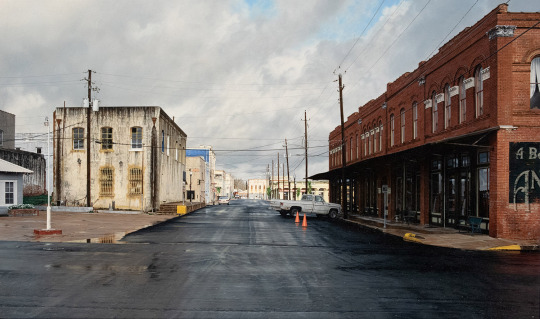
Rod Penner: The Latest Picture Show
By Lawrence Nassau
Painter Rod Penner is a poet of precision and atmosphere, and his solo exhibition, “Small Town Meditations," presented at Louis K. Meisel Gallery, is a symphony of stillness and barely imperceptible movement.
The places and spaces that stand as Penner’s subjects are seductive scenarios, where big skies meet low-lying commercial districts, gardens come together with single-family homes, and roadways minuet with horizon lines.
Each of Penner’s paintings is non-narrative. However, a compelling story is told within each of his tableaux. Each conveys the moment of arrival and, simultaneously, points towards the moment of departure. In a most capable fashion, the artist dramatizes the experience of encountering an overall scene and detecting its most salient details. He does so by harmoniously orchestrating them in acrylic on canvas and expressing them with great visual effect.
The synergy of the exhibition's several dozen works - produced by Penner in his Texas studio between 1998 and 2023 and strikingly installed in an all-encompassing manner by the gallery within its singular, central salon - makes for a scintillating art-viewing experience.
The range of Penner’s works is broadly split between townscapes, portraits of homes and businesses, and hybrids of the two. Often, a roadway - paved or unpaved - meets the viewer in the foreground of each scene and carries their eye upward, towards a horizon or a vanishing point that resides in the background. In some instances, Penner sets up an immersive environment for the viewer. In others, he establishes a plateau, on which an up-close avenue or garden appears to begin just across the proscenium, formed at the border of each composition, and expands fluidly in all directions or in stages towards the distance.
Penner’s approach to achieving a balance of simplicity and complexity is fully realized in each and every work. There’s a maturity of concept and an excellence in practice in both the earlier works and those that are most recent.
While one might expect the most recently completed works to be the most audacious, it is “Bar-B-Q / Marble Falls, TX,” produced in 2022, which, if it wasn’t as restrained as most of his other works, might be considered borderline surrealistic. The artificial lighting on the façade of the restaurant here is active in a dawn or dusk setting. Through scattered cloud cover, sunlight can be seen bending over the horizon line. On the surface of a shallow puddle in the foreground, reflections of portions of the illuminated portions of the fire-red frontage of the building can be seen.
Works from René Magritte’s nocturnal landscapes beneath sunlit skies come to mind first. A closer look towards the background may also remind one of the sensibilities of the Hudson River School. Aficionados of the establishing shots in “Twin Peaks,” David Lynch’s television series, might agree how they kindredly point towards how this and other Penner paintings tend to activate an inquiring state of mind. (What and/or who are inside of these structures? Who has just passed here? Who will imminently appear here, and how will they do so? Which of the rhythms of nature have enveloped the viewer here, and which will manifest itself next?)
While one might initially assume that Penner’s paintings are static, it becomes readily apparent that they are dynamic. Each has a heart and a mind, which, in turn, are governed by a guiding hand - one that enables a viewer to complete a picture.
In “Clearing Skies / Bertram, Texas,” Penner presents a view of a broad, open space, bound by a line of far-off trees; a yellow building; a confluence of linear motifs (consisting of horizontal electrical wires and vertical utility poles and towers); a commercial district, enlivened by bumper-to-bumper vehicular traffic; and blue skies, punctuated by an array of shadow-fringed clouds. Bands of early morning sunlight transect the foreground, which is heavily covered by cast shadows. Midway through the depth of the right-hand portion of the field of view is the façade of a brick building.
It could be said that what’s found here is a North American response to the invention of modern painting, namely that which is embodied by Jacques-Louis David’s “The Death of Socrates.” A side-by-side comparison of the two works would show Penner’s brick building corresponding to the wall behind Socrates and Penner’s roadway corresponding to the corridor at the left in David’s painting. The trees and structures bordering Penner’s roadway and the cloud cover above could be said to correspond to the arch of the corridor in David’s painting, and the scrum of motor vehicles at the rear could conceivably correspond to the figures departing via the staircase of David’s painting.
Concurrently, “Clearing Skies / Bertram, Texas” calls to mind Thomas Cole’s “View from Mount Holyoke, Northampton, Massachusetts, after a Thunderstorm - The Oxbow,” which depicts nature and civilization co-existing, side-by-side. While Penner and Cole have structured the respective compositions differently, they portray both domains harmoniously, albeit in a balance that is benignly uneasy. Entropy is a theme in both works; Cole looks more towards storm-driven forces, and Penner looks more towards a gradual wearing away of structures and surfaces by the natural elements but mostly by the movement and weight of motor vehicles.
The clarity that Penner brings to “Clearing Skies / Bertram, Texas” is strategic yet effective in its counter-intuitiveness. In this idiosyncratic memento mori the brick building and its brightly sunlit surface can be seen as the “candle” in the composition, á la Georges de la Tour’s “The Penitent Magdalen.” It is reflected in the puddle, as de la Tour’s candle is reflected in the framed mirror. In the reflective surfaces of both works, the image is distinct from that which is reflected; dependent on the vantage point engineered by each artist; and transient, as the puddle can evaporate and the mirror is composed of a fragile substance. Furthermore, shadows in both works can be read in realist and abstract terms.
To stimulate elements of the mind that go beyond the linear and the two-dimensional in “Clearing Skies / Bertram, Texas,” Penner presents an upside down view of the façade of the building. By doing so, he enables the viewer to effortlessly accept the text of the right side up signs and their upside down counterparts on equal terms. In a manner of speaking, Penner has a viewer’s brain doing somersaults while enjoying a very pleasing sense of equilibrium. In this regard, he explores the deployment of reflected images that also interests Jasper Johns in his crosshatch paintings. Like a songwriter who recognizes the pleasure of repetition and inversion, Penner has created a visual melody in this exurban tableau.
Although there is much focus on the mastery that can be analytically and intuitively detected in Penner’s works, it is the simple pleasures of his works that draw in the viewer. The fulfillment that can be achieved by merely glancing at his work and can be enriched by further engagement is easily accessible. In an exhibition, such as “Small Town Meditations,” one may be moved whilst moving through the real space of the gallery and taking pleasure in the moments virtually portrayed in Penner’s substantially present paintings.
“Rod Penner: Small Town Meditations”
Louis K. Meisel Gallery
18 March - 29 April 2023
New York
May 2023
0 notes
Photo
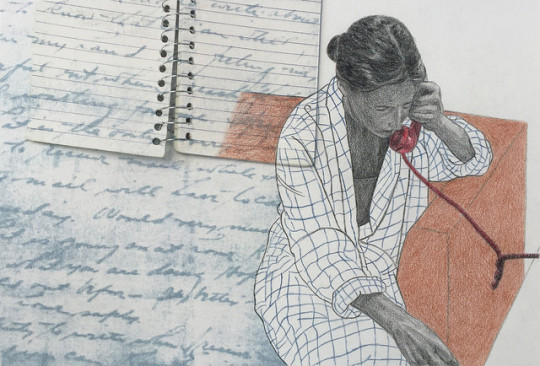
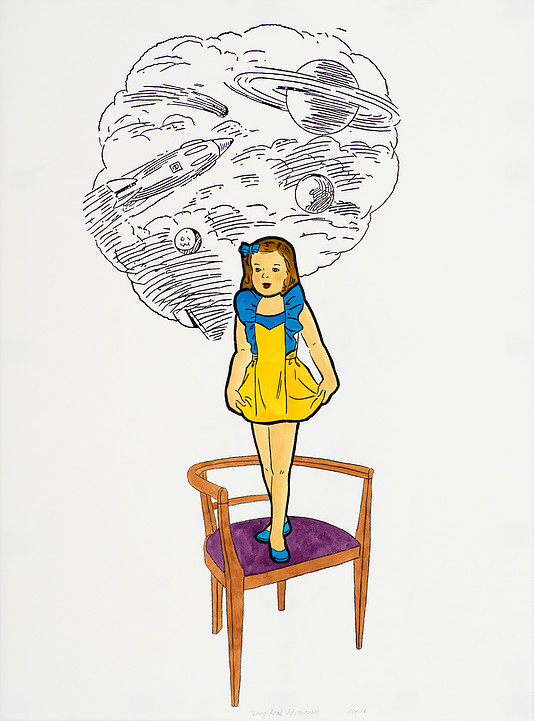




About Minna Resnick
By Lawrence Nassau
In academia, instructors live by “publish or perish,” the imperative to get papers published in journals in order to thrive in their careers. For art instructors, the corollary may be “exhibit or expire.” As the Ithaca-based Minna Resnick has solidly constructed an online survey exhibition of her prints and drawings on her web site, she is sure to continue thriving in her career as an artist and art educator.
In much of her work during the past 14 years, Resnick has been harmoniously super-imposing images upon other images. Some of the images have been sourced from vintage printed matter (including wallpaper), and others are drawings or prints of drawings, which often originate from photographs she'd taken. At times, Resnick makes use of existing photographs, including those from her own photo collection. As one regards Resnick's compositions, Sigmar Polke and Francis Picabia come to mind. Additionally, her tendency to comment on the female condition reminds one of the collages of Alexis Smith.
Threads of several themes may be detected across the many series of works that Resnick has done. The relationships between girlhood and womanhood and between innocence and maturation are seen in many works. Coupled with works that depict flora with fauna - typically birds - Resnick appears to be postulating that it's nature's way for each creation to exist and co-exist. However, she does not appear to allow for the relationships between life forms to go unquestioned, as her juxtapositions of females and males elliptically point to how archaic assumptions and situations were for females in previous times. The message is subtle, and the way that images are interwoven suggests that an engagement exists between life forms - girls and women, boys and girls, men and women, humans and flora/fauna, etc. By working in traditional ways and by taking an array of contemporary approaches in expressing her visual hypotheses, Resnick seems to be demonstrating her belief that the past and the present are dynamically intertwined, as well. Whether or not progress - whatever that may mean - has been made, she leaves it for the viewer to decide.
On her web site, Resnick has posted a curriculum vitae and a selection of statements, which collectively function as a catalogue and an array of wall texts would in a gallery or museum exhibition. She sojourned in Northern California in the early 1970's, earning an MFA at San Francisco Art Institute and concurrently studying printmaking at California State University, Hayward. One might surmise that Resnick was highly aware of or participated in the pioneering feminist art discourse that was prevalent in California at the time. Resnick also describes in great detail the methods and materials she's employed in producing her work. Resnick's commitment to excellence and her drive to investigate and innovate become evident, as one regards the images of her work and assimilates them as one reads her studio testimonies.
Now, during Women's History Month, it is most fitting to examine and appreciate Resnick's many accomplishments. Her work is elegant and dynamic. Its visual cues are fluid. Its timelessness make it current and relevant. The presence that one senses in her online presentation prompts the question, "Where and how soon can one see Resnick's work in-person?"
NewYork, March 2018
#minnaresnick#americanart#feministart#drawings#prints#worksonpaper#alexissmith#francispicabia#sigmarpolke
1 note
·
View note
Photo


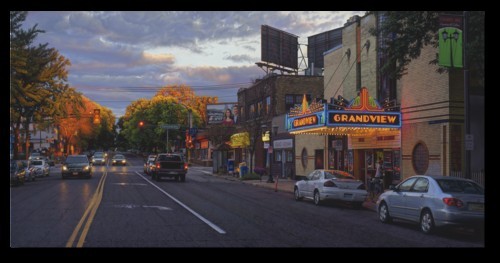



Correspondence Concerning the Paintings Of Davis Cone
By Lawrence Nassau
Correspondence between “M” and “Q” from the National Intelligence Archives on Declassification Day.
M: It appears that, in recent years, Davis Cone has considerably advanced the genre of Photorealist painting.
Q: Indeed, Cone has achieved a greater sense of depth in the works he's been producing over the past ten years. He doesn't emphasize the inherent flatness of photographs, as other Photorealists have done.
M: Instead, Cone's works from 2008 through today seem to counterpoint some of the rich and colorfully printed photographs that have been ascendant in art gallery and museum exhibitions since the mid-1990’s.
Q: Are you referring to the works of Philip-Lorca diCorcia, Gregory Crewdson, and Andreas Gursky?
M: Yes. And also those by William Eggleston, who's been on the scene since the late 1960's.
Q: Of course, Cone's work has a physical presence that actual photographs don't have.
M: That's true, but, what Cone is doing is a New Photorealism, as he is more fully dimensionalizing his subject matter.
Q: Kind of like what Bob Dylan had done when he had gone "electric" at the Newport Folk Festival in 1965.
M: If you're referring to how Cone, as a photography-informed, precisionist painter, has been claimed by the Photorealist audience despite the fact that he has always taken liberties with his original source materials and worked towards achieving his artistic goals, the answer is, "Yes."
Q: It's just that his gradual development as an artist from one set of paintings to the next has concealed how his work has evolved. Cone can now be more readily recognized as an atmospheric painter. His work has never been about merely documenting motion picture house façades.
M: Indeed, in Cone's "Rogue" and "El Rey," shafts of sunlight pour through the streets that front each of these cinemas. They don't appear as lens flares.
Q: Likewise, in "Kiggins/Marquee Scrabble," the sun's light appears to be bending around the upper reaches of the building. Here, Cone celebrates the construction and the form of the Art Deco design of this particular movie house, as well as the sunlight that envelops it. The result is poetic and convincing.
M: And, as Cone increasingly depicts spaces that are more open, inviting, and natural, his affinity for the Hudson River School becomes more apparent.
Q: In "Grandview," the warmth of the late afternoon sunlight on the fully-leafed trees reveals the beauty of early autumn, as the orange-brown foliage co-exists with the green foliage. In "Lark/Double Portrait: Bay Light," Cone depicts a summer scene, as the foliage is in a wide variety of greens.
M: In both works, the trees are in the distance, past what is probably the central business district of each of the communities that are depicted.
Q: In "Grandview," most of the trees line both sides of a central street in an area that is probably residential. In "Lark/Double Portrait: Bay Light," the trees at the end of the road are closer together; they mark the start of a forested area, which rises onto hills that are further in the background.
M: The placement of the downtown areas in the foreground and the arboreal areas in the background calls to mind the paintings of Thomas Cole, who depicted the distinctions between the domesticated or civilized world and the natural world.
Q: Interestingly, Cole showed the two concurrently side-by-side in "View from Mount Holyoke, Northampton, Massachusetts, After a Thunderstorm" (a.k.a., "The Oxbow") and, temporally, one replacing the other in the series, "The Course Of Empire," while enabling the viewer to take in both worlds from the same central vantage point.
M: Cone, however, situates the central business district in the foreground in both "Grandview" and "Lark/Double Portrait: Bay Light," and separates the viewer from the more natural settings, which are in the background.
Q: Since Cone is primarily concerned with compositional dynamics, his motives for doing this are likely to have little or nothing to do with any attitudes he has about Romanticism.
M: The movement of energy through the planes of his paintings appears to be of critical importance to Cone. In this way, he is like Brigid Riley, who has often addressed how speed is manifested within paintings.
Q: Two of Cone's earlier works reflect the significance of this concern to him. "Criterion" is about mobility, and "Metro" is about immobility.
M: The motor vehicles and pedestrians moving rapidly through the Times Square area at nighttime in "Criterion" and the vehicles parked or at a standstill in the snow on a tranquil stretch of Broadway in a residential area of New York's Upper West Side on a sunny afternoon in "Metro" represent a study in contrasts.
Q: Within a singular composition, such as, "Normal Theater," Cone depicts the commingling of artificial light and natural light.
M: Like René Magritte, who sometimes presented how, in the sky, the early morning light can be bright and tight, and how, at street level, the illuminated light of the lamps of the pre-dawn hours can appear to be moody and evocative, Cone merges the light of the marquee of the cinema with the remains of a cloudy day in "Normal Theater."
Q: Although "Normal Theater" is not a noir painting, Cone succeeds in showing the gradual takeover of the night here, reinforcing this with the presence of pedestrians who appear to be moving slowly in front of the theater.
M: In these times, who can measure such a triangulation except a skillful, visionary painter?
Q: There is research and development being done on artificial intelligence with a view towards enabling technologists to mimic natural intelligence.
M: Cone, however, is not concerned with predictive modeling.
Q: As a drummer in a jazz combo during his formative years, Cone knows about improvisation and syncopation.
M: Cone is not concerned with idealism. He allows for the idiosyncrasies that can be found in his source materials.
Q: Working with photographic transparencies, through which light is transmitted, he applies paint to surfaces, upon which light is reflected.
M: The process itself is counter-intuitive.
Q: However, it does not yield an anti-logical solution.
M: It's not a solution to anything at all.
Q: Cone's work is an expression of his unique way of being.
New York, January 2018
Bibliography
Kinerk, Michael D., and Dennis W. Wilhelm. "Popcorn Palaces: The Art Deco Movie Theatre Paintings of Davis Cone." New York : Harry N. Abrams, 2001.
#daviscone#americanpainting#andreasgursky#artificialintelligence#bobdylan#brigidriley#contemporaryart#gregorycrewdson#newphotorealism#philiplorcadicorcia#photorealism#renemagritte#williameggleston#thomascole#lawrencenassau
0 notes
Photo


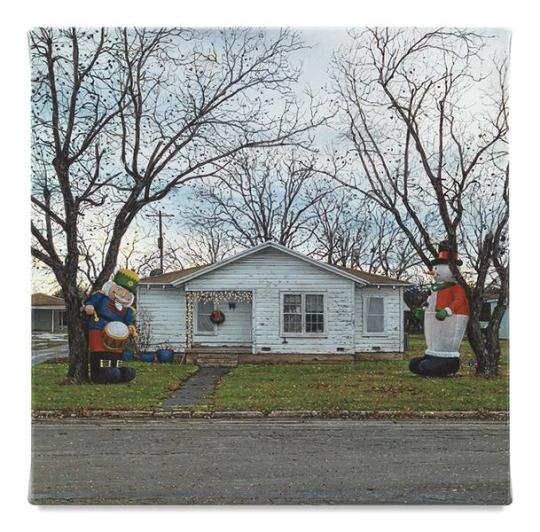
Rod Penner and Photorealism In the New Digital Era
By Lawrence Nassau
In the early 1990’s, Rod Penner arrived in New York City from out of nowhere.
From outside of Houston, specifically.
By car, transporting a painting he’d done.
The work, measuring about 24 x 36 inches, depicted a suburban home with a verdant front lawn.
The painting astonished gallerist Ivan Karp and his staff at O.K. Harris Works Of Art.
When asked about his background, Penner said…
- He was originally from Vancouver, Canada.
- He had studied art at Oral Roberts University.
- And, from the beginning, he had aimed to be a photorealist painter.
Penner didn’t emerge from an academic, beaux arts tradition or merely a precisionist milieu.
He looked at photorealist books and learned from them as points of departure.
At one point, Penner was asked why the blades of grass in this particular painting were expressively articulated. "Because, in real life, they are thick and coarse,“ he replied.
It was the last work of art that Penner had ever done that was a hybrid representation of both nature and photography.
Since then, Penner has been purely a painter of photographs.
Primarily of the exteriors of small town and suburban homes, storefronts, and commercial buildings of no particular note.
Except for how they are visually represented - factually and evocatively - by the artist
Also of roads and intersections.
Upon which the only discernible activity is that they catch sunlight and cast shadows during the middle of the day and reflect artificial light during the middle of the night.
Occasionally, the rising or the setting of the sun suggests the possibility of the passage of time in his paintings.
So subtly so that, by remarking upon the occasion, one would have to also note that the event is equal in weight to everything else in the composition.
Noticeably - and fortunately so for his audience - Penner has refined and updated his approach during each and every phase of his career.
This is what he has in common with the earliest painters of photorealism, who were acknowledged 45 to 49 years ago for perceiving realism in new ways and, along with the earliest minimalist painters, for producing the most extraordinary works without revealing the touch of the artist’s hand.
One can comment on Penner’s technique in achieving this effect. It’s been noted that he uses "brushes as small as #000, [as] he renders each worn brick, pavement crack, and fallen leaf in precise detail.”
However, it all starts in the mind.
The mind that motivates the artist to identify views.
Which prompt him to pause.
With his camera.
And record them.
And to which he has no emotional attachment.
Penner has stated “that ’…having grown up in Canada, I’m thankful I don’t have any childhood memories of these small Texas towns that might interfere with my observations.’”
Penner, of course, edits each source image in order to achieve the effects that he is after in creating each composition.
Minimizing. Amplifying. Cropping. And pulling back in order to establish broader views and/or to allow for a store sign, a length of a parking lot curb, or a pair of inflatable snowmen to appear - but for a moment - as a feature of interest in a painting.
Most notably, it is Penner’s choosing to paint small-scale works that is of significant interest now.
During a solo exhibition of Penner’s paintings at Ameringer | McEnery | Yohe, New York, from April 27 to May 26, 2017, viewers could encounter an extraordinary body of works, each of which measured either 5 x 7-½ inches or 6 x 6 inches.
In regarding each work up-close, one could immediately detect a sense of expansiveness in the small, Texas town settings that Penner has chosen to depict.
It’s all very harmonious.
“Commie’s Tacos,” for example, is really about the space surrounding the eatery, which is partially - and not entirely - depicted towards the right of the composition. The street in front of the establishment sets the building back for the viewer. The street at its side vertically bisects the image, and, the utility pole (and the wires emanating from it) functions as a visual tent pole for the work. The wires are connected to several buildings further to the rear and off to the side and to a more distant pole, and they call attention to and amplify the physical presence of the sky, itself a mixture of cloudiness and blueness.
“G & R Grocery” depicts the eponymous store, which is set back in a parking lot of what may be a shopping strip. The long, deep cracks in the asphalt run towards the shop. The parking area directly in front of the store is paved with red brickwork; its horizontal orientation - as well as that of the concrete sidewalk immediately before the store - very subtly brings the viewer closer into the scene but also act as a sort of boundary between where a driver presumably enters the lot and the store itself.
In “Yard Inflatables,” a pair of tall decorative inflatables - a somewhat sagging, bearded toy soldier with a drum and a snowman - flank the sides of the front yard of a suburban home. Bare trees buttress the jolly inflatable figures. The grass is green, albeit with barely noticeable brown patches, and its horizontality draws attention to the the black asphalt road before it and the white house behind it. The white paint is conspicuously peeling, but the front porch is tastefully, yet simply, adorned with white Christmas lights and a wreath. The sky, which is visible behind the tallest and slenderest of the trees’ branches, is a blend of blue skies and white clouds. On the roof, one can say that the antenna resembles a cross. Although “Yard Inflatables” looks optimistic, it is not sentimental. It is, however, one of a number of works by Penner that is characterized by romantic tendencies.
Penner’s small-scale works - in the age of Instagram and a world with hand-held smartphones and tablet computing devices - seem to be in synch with how, in the current decade, pictures are viewed and also how reality is perceived. Landscapes in these sizes have existed for centuries, and Penner has produced many medium and large paintings throughout his career. Nevertheless, his most recent works are most timely and relevant.
New York, October 2017
Bibliography
Hillings, Valerie L. “Picturing America : Photorealism In the 1970’s.” New York : Guggenheim Museum Publications; Berlin : Deutsche Guggenheim, 2009.
“Rod Penner,” Ameringer | McEnery | Yohe, New York, April 27 to May 26, 2017.
#rodpenner#canadianpainting#contemporaryart#guggenheimmuseumberlin#painting#newyork#photorealism#soloexhibition#texas#lawrencenassau
1 note
·
View note
Photo




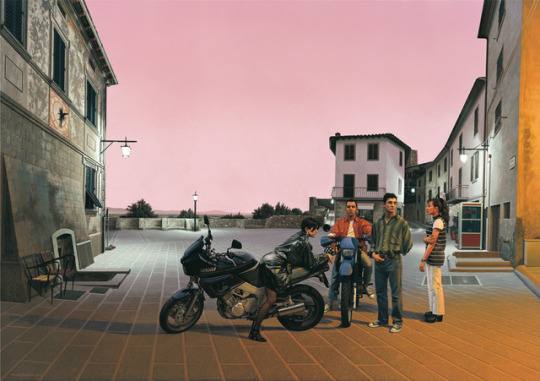

The Beautiful, Precise World of Johannes Müller-Franken
By Lawrence Nassau
In his paintings, Johannes Müller-Franken depicts a world of humans, present-day individuals, maneuvering through discrete moments of their daily lives. They are impeccable – both the paintings and the people. The places in which these individuals exist are warm and inviting. Marveling at them and their appearance is, perhaps, the most rewarding thing to do while regarding Müller-Franken’s precisionist paintings.
During a solo exhibition of works by Müller-Franken at Bernarducci.Meisel.Gallery, New York, from June 1 to July 21, 2017, a viewer could go from one picture to the next and see how the artist celebrates the act of looking while manifestly presenting a hypothesis of what is possible for life here on Earth. Neither specimens of Platonic idealism nor of phony refinement, the people portrayed by Müller-Franken are not living the dream but living the poem.
One could say that the artist is often contemplating the conundrum of the chicken and the egg. He alternately examines existence and creation. As one typically produces the other, Müller-Franken employs a light touch in making this dynamic felt.
In “Nocturne,” a young lady, wearing an overcoat is seen, standing in a snowy, wooded landscape next to an isolated, modern country house. She is looking up at a 45-degree angle, presumably towards a full moon, as suggested by the distinctive shadows cast by her and the nearby trees in tandem with the bright light falling upon her face and the surrounding virgin snow. In the distance, a campfire is going in the backyard, and, behind her, the electric light of a lamp is illuminating the home’s interior, which is visible through a window. She is harmonious with three sources of light, which originate from three different planes. Like a figure in a Caspar David Friedrich painting, she is gazing at the phenomenon that is the moon; however, unlike a typical Friedrich figure, this young lady is presented to the viewer from the front and not from behind. She appears to be more enchanted by that which may be ever-present in the natural world than that which may be ignited and/or human-made. Müller-Franken further explores variations on these themes in “Les Indes Galantes” and “Aus der Neuen Welt,” each of which depict multiple figures, who appear to be illuminated by distinct, multiple sources.
Through his portrayal of socially engaged subjects, Müller-Franken amplifies his investigation of how to effectively create scenes of individuals in three dimensions by revealing a fourth dimension or multiple facets of one. Sentience and the passage of time are as much a part of the artist’s works as are pieces of furniture, buildings, and clothing. Transitional moments of day and night are depicted in “Aus der Neuen Welt” and “Piazza Mazzini.” In the former, a trio of ladies is minding a campfire in a park and, in the latter, a couple, seated on motorcycles, and a couple, standing next to them in a piazza, appear to be deep in thought; they are, perhaps, contemplating their next move. In, respectively, “Girlfriends IV” and “Kajal,” a pair of young ladies are seated where the end of a train platform and the top of a set of stairs meet. The figures are different from one painting to the next, but the point of view and the train station are the same. In both works, the young lady on the left is applying eyeliner to the one on the right. The scenario in the former takes place in the dead of night, and the figure on the right seems to be regarding the celestial bodies in the nighttime sky above; the broadly illuminated scenario in the latter takes place during the interval that typically marks the transition of day and night, and the figure on the left appears to be making good use of the available light of the “magic hour” in order to apply make-up to the face of the figure on the right.
That Müller-Franken has progressed from having the figures in his paintings go from merely being his subject matter – actors performing tasks – to being thinking and feeling human beings - vital contributors to each other and to the environments which they inhabit – it is more than his having achieved a technical leap forward. In a way, the artist has populated his paintings with surrogates of their own creation. Like his paintings, his subjects are warm and immaculate. They are kitted up from head to toe, wearing garments that are beautiful (within a particular range of taste) in texture and design. These individuals are groomed with great care. In certain ways, they are comparable to the artist’s paintings, themselves, as they are wholly and mortally formed, yet essentially lacking in surface incident. The physical attributes of the figures and their surroundings echo those of the artist’s paintings; they are sensuous and gently dynamic. As every square-inch of Müller-Franken’ paintings and the subject matter depicted within them is impactful and of equal importance, it could be said that he produces all-around works of art, which correspondingly represent all-around lives.
Müller-Franken is working within an ongoing tradition of portraying subjects who are creating themselves or others. In the 1983 painting, “La mano ubbidisce all’intelletto,” by Carlo Maria Mariani, two neo-classical male nudes are creating each other with paintbrushes, as they simultaneously exist as representations of human beings and subjects of a work of art. “Marina schminkt Luciano,” a 1975 painting, by Franz Gertsch, is part of a series of works depicting several friends of the artist, passing the time, grooming themselves, and flamboyantly getting dressed up; in this case, one, who is vividly made up, is making up another and equally so. In what is, perhaps, his most fully-realized all-around work, “Caserne Poya,” Müller-Franken portrays a pair of young ladies, dressed in cheerleading outfits, and the one who is sitting up is applying make-up to the other, who is reclining.
“Marina schminkt Luciano” and many other paintings produced by Gertsch, are photorealist, as the source material clearly comes from camerawork. In both “Marina schminkt Luciano” and the 1973 painting, “At Luciano’s House,” the figures and their surroundings appear to be illuminated by flash. Müller-Franken’s paintings are sometimes considered photorealist, however, the artist’s source materials are not revealed in any particular way. His works are as detailed as photographs or as paintings of photographs may be, however, they do not conspicuously feature lens flares, pixels, or any other characteristics associated with imaging media. Like Richard Hamilton, who had produced modern-day (and even up-to-the-moment) interpretations of the works of the old masters, especially late in his career, Müller-Franken uses contemporary ways of seeing and producing works, as he stands on the shoulders of selected old masters.
Müller-Franken’s annual production of paintings is quite scarce. He appears to be completing about two works per year. To have taken an opportunity to see a dozen or so of his works in a solo exhibition was a real pleasure. Aficionados of the fine arts – especially painting - are well advised to see Müller-Franken’s paintings whenever they are exhibited in public. The experience will be rare and incredibly worthwhile.
New York, September 2017
#johannesmullerfranken#contemporaryart#germanpainting#hyperrealism#soloexhibition#newyork#painting#bernarduccimeiselgallery#carlomariamariani#caspardavidfriedrich#franzgertsch#richardhamilton#lawrencenassau
3 notes
·
View notes